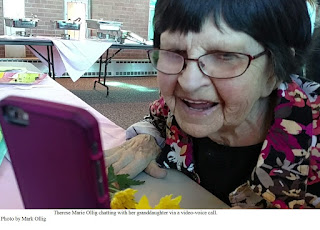by Mark Ollig
Copyright © 2016 Mark Ollig
Copyright © 2016 Mark Ollig
This past Mother’s Day, I, along with other family
members, were in Winsted, MN visiting with my mom.
One of my mom’s granddaughters lives out of state, on
the west coast, and was unable to visit in person.
However, the distance apart did not prevent them from
seeing and talking with each other.
My niece, who was also visiting, used modern-day
technology to bring them both together.
She placed a video phone call using a software app
(application) on her cellphone.
With the display screen and camera of the cellphone
held in front of my mother, she smiled upon seeing the face of her
granddaughter, as they both talked and acknowledged each other’s facial
expressions.
The video call was placed using Apple’s FaceTime app.
Today, more people are commonly using FaceTime and
other video-calling apps for placing face-to-face video phone calls.
I say commonly, because my niece made the video call so
effortlessly; more or less the same as placing a voice call.
Video-voice calling technology has been around for many
years.
It was seven years ago when I placed my first video
call – but it was not over a cellphone.
This call was to my oldest son, who at the time was
taking classes at the Academia de Bella Arte School in Florence, Italy.
Skype is the name of the video-voice conferencing
program I had downloaded onto my desktop computer.
This video call was placed over the Internet, and to my
surprise, everything worked very well.
On my computer’s display monitor, a smaller screen
appeared in the upper right-hand corner showing the live camera view from my
son’s laptop; which, of course, was pointed at him.
I smiled while looking into the camera on my computer,
and cheerfully said; “Hello, Mathew!”
He smiled back; the video quality was surprisingly
good.
While we talked, he gave me a panoramic view of the
café in Florence where he was having coffee.
The café looked very inviting. I could see its many
patrons seated at tables, drinking coffee.
Mathew’s laptop was using the Wi-Fi connection to the
Internet from the café, which was some 4,750 miles away from where I was
located in Minnesota.
During the 1964 World’s Fair, the Bell System’s
(AT&T) highly-anticipated Picturephone presentation took place.
The Picturephone used a video camera, monitor screen, a
push-button or touchtone telephone (which in 1964 was impressive in itself),
audio speakers, and a power supply.
The video camera inside the Picturephone used a
Plumbicon tube, which I learned was commonly found in commercial television
broadcasting cameras.
In an archived demonstration video, I noted the sound
and video quality of the Picturephone was very good; the real-time visual of
the person seen on the monitor screen appeared in black-and-white.
The people using it looked to be both amused and
delighted upon seeing the person they were speaking with over the video
telephone.
Picturephone video booths were installed in a few city
test markets in 1965; however, the cost of placing a video call was very
expensive, and having to physically place the call away from one’s home or
business, proved unpopular with the public.
By 1968, most of the Picturephone booths were no longer
in use.
I uploaded a photograph of the reportedly first
videophone call using the Picturephone, from April 20, 1964.
It can be seen on my Photobucket webpage:
http://tinyurl.com/bytes-p1.
I digress back to Mother’s Day, recalling my mom’s
smiles from not only hearing her granddaughter’s voice on the cellphone, but
being able to see her over its display screen, as well.
“It was the first time I could see the person I was
talking with over the phone,” mom cheerfully told me.
During the 1940s, my mother was a telephone switchboard
operator.
I smiled back at her and thought; “Sometimes,
technology gets it right.”
Follow me via the social media network Twitter, at @bitsandbytes.
